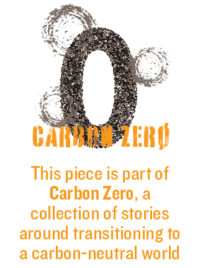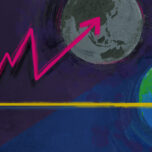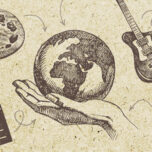September 15, 2023 —  Recent news articles about a breakthrough in nuclear fusion research heralded the potential for “limitless” energy. Whenever I read that word limitless I wince. The promise of limitlessness is misleading and sometimes deadly.
Recent news articles about a breakthrough in nuclear fusion research heralded the potential for “limitless” energy. Whenever I read that word limitless I wince. The promise of limitlessness is misleading and sometimes deadly.
Limits exist everywhere in nature. They enable the functioning of systems at scales from the subatomic all the way up to galaxy clusters. If there is any physical thing that could credibly be claimed to be infinite, it is the universe itself. Everything else has boundaries.
Limits and Indigenous Wisdom
Ancient peoples confronted limits every day. In addition to personal limits on strength and endurance, there were also limits to environmental capacity. Overhunt game or overharvest wild plants this season and starvation could follow in the next.
One solution was to move to new habitats. By migrating, people escaped the confines of familiar places, but the benefit was temporary. Human migration altered environments and reduced biodiversity.
However, people who stayed in one place long enough learned the limits to their bioregion’s capacity for regeneration. Through a long series of tough lessons, they discovered how many plants of each kind they could harvest and how many of each kind of animal they could hunt. In short, they adopted a worldview and behaviors oriented toward successful adaptation to the finite.
The Restless, Voracious Modern Mind
That changed for some people, starting just a few thousand years ago.
The development of mathematics provided a logical basis for the belief in infinity. It facilitated the expansion of trade. It also helped in the invention and refinement of technologies that assisted in the conquest of Indigenous peoples, allowing conquerors to overleap previous constraints on the scale and wealth of human societies.
At the same time, agriculture enabled population growth, but it gradually robbed soils of nutrients. Sailing ships increased trade but building them led to the deforestation of whole continents. A reckoning with limits seemed to be in store.
Then a miracle happened: People started using fossil fuels. Coal, oil and natural gas enabled the development of transport technologies that overcame prior limits to travel and trade, so products and resources that were abundant in one place could be transported to places where they were scarce. Fossil fuels could be used to increase the rates of resource extraction. They could be fashioned into plastics and chemicals to substitute for natural materials that were getting scarce. And they could be made into artificial fertilizers to support unsustainable agricultural practices.
All these developments together enabled human numbers to expand from 1 billion to 8 billion in just over two centuries. We were, in effect, stretching existing constraints on population and consumption to the point that it was difficult for many people to see that boundaries still existed at all.
Limits Snap Back
But problems are brewing.
It turns out that fossil fuels suffer from a couple of serious drawbacks: depletion and pollution, including the release of CO2, which causes climate patterns to become more chaotic and threatens the ecological cycles that support myriads of creatures in addition to us.
The Global Footprint Network currently shows humanity using resources as if we lived on 1.75 Earths — which it is only possible to do by, in effect, robbing future generations.
If the energy-climate conundrum were all we had to worry about, the obvious answer would be to transition industrial society to operate on other, less problematic energy sources. But the energy-climate problem isn’t our only survival-level ecological dilemma.
As we’ve grown our population and consumption, we’ve been taking habitat away from other organisms. Animal species have suffered average population declines of nearly 70% in the past 52 years and thousands of plant species are endangered as well. Not only that, but we are exhausting the materials that feed the industrial machine. As high-grade ores deplete, miners are forced to dig deeper and process more ore in order to produce the same amounts of copper and other critical materials.
Scientists at the Stockholm Resilience Centre calculated that, of nine critical global ecological thresholds that might lead to collapse, humanity has already crossed six. And the Global Footprint Network currently shows humanity using resources as if we lived on 1.75 Earths — which it is only possible to do by, in effect, robbing future generations.
Altogether, civilization’s survival dilemma in the 21st century is best described by a concept from population ecology — overshoot. This refers to the situation where a crucial resource temporarily becomes more abundant, thereby enabling a group of organisms to grow its population beyond levels that can be sustained over the long run. Temporary energy abundance has led to more food, more people, more commercial products, more knowledge, more comfort and more convenience. But we are about to become victims of our own success.
The key will be a willingness to view limits not as restrictions to be fought against, but as boundaries that enable systems to work. We need to not just respect limits, but to celebrate them and work in harmony with them.
Indeed, humanity’s confrontation with limits will make this century pivotal. Our survival will depend on whether we can restrain population growth, resource extraction and waste dumping so that we can get onto a sustainable path. That means de-growing economies, starting with the wealthiest ones like that of the United States.
But culturally we are ill-equipped for this re-adaptation process. Indigenous wisdom, which should be our guide, persists in traditional societies. Everywhere else, the dominant worldview holds that talk of limits is dreary, scary, unimaginative and uninspiring. Where limits are undeniable, we try to finesse them with clever math (carbon credits, anyone?) and sophisticated technology.
The Pleasure and Solace of Loving Limits
We have flown so far from safe boundaries that our only possible landing path entails a crash: The policies required to fully align our industrial system with nature’s sustainable productive capacity would trigger enormous economic and political problems. This is not to say that activists should stop protesting new fossil fuel production projects, or that planning agencies should stop advocating more energy efficiency and solar panels, or that conservationists should stop protecting creatures and ecosystems. We must do what we can, even if it’s not enough to avert all the crises that we’ve been fomenting with decades of overconsumption.
However, in addition to such worthy efforts, at least some of us can adopt an attitude geared to find an equitable way through the Great Unraveling while laying the foundation for a truly sustainable society. The key will be a willingness to view limits not as restrictions to be fought against, but as boundaries that enable systems to work. We need to not just respect limits, but to celebrate them and work in harmony with them.
Wisdom says: embrace limits even as they snap back, knowing that, in the long run, everything moves toward balance. It’s a philosophy that’s especially relevant in difficult times, such as ones we are entering, when it may be helpful to remember: This too shall pass. Even the craze for limitlessness has its limits.
Editor’s note: Condensed with permission from Resilience.
The views expressed here are those of the author and not necessarily of Ensia. We present them to further discussion around important topics. We encourage you to respond with a comment below, following our commenting guidelines, which can be found on this page. In addition, you might consider submitting a Voices piece of your own. See Ensia’s Contact page for submission guidelines.
Related Posts
Ensia shares solutions-focused stories free of charge through our online magazine and partner media. That means audiences around the world have ready access to stories that can — and do — help them shape a better future. If you value our work, please show your support today.
Yes, I'll support Ensia!




